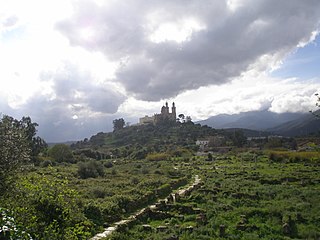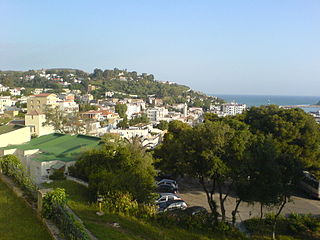
Hippo Regius is the ancient name of the modern city of Annaba, Algeria. It historically served as an important city for the Phoenicians, Berbers, Romans, and Vandals. Hippo was the capital city of the Vandal Kingdom from 435 to 439 C.E. until it was shifted to Carthage following the Vandal Capture of Carthage (439).

The History of North Africa during the period of Classical Antiquity can be divided roughly into the history of Egypt in the east, the history of Ancient Libya in the middle and the history of Numidia and Mauretania in the West. The Roman Republic established the province of Africa in 146 BCE after the defeat of Carthage. The Roman Empire eventually controlled the entire Mediterranean coast of Africa, adding Egypt in 30 BCE, Creta et Cyrenaica in 20 BCE, and Mauretania in CE 44.

Cirta, also known by various other names in antiquity, was the ancient Berber and Roman settlement which later became Constantine, Algeria.

Tabarka is a coastal town located in north-western Tunisia, close to the border with Algeria. Tabarka's history is a mosaic of Berber, Punic, Hellenistic, Roman, Arabic, Genoese and Turkish culture. The town is dominated by an offshore rock on which there remains a Genoese castle. Nationalist leader Habib Bourguiba, later president of post-independence Tunisia, was exiled on Tabarka by the French colonial authorities in 1952. Tourist attractions include coral fishing, the Coralis Festival of underwater photography, and its annual jazz festival.

Zaraï was a Berber, Carthaginian, and Roman town at the site of present-day Aïn Oulmene, Algeria. Under the Romans, it formed part of the province of Numidia.
Leptis or Lepcis Parva was a Phoenician colony and Carthaginian and Roman port on Africa's Mediterranean coast, just south of the modern city of Monastir, Tunisia. In antiquity, it was one of the wealthiest cities in the region.
Thagora was a Carthaginian and Roman town at what is now Taoura, Algeria.

Madauros was a Roman-Berber city and a former diocese of the Catholic Church in the old state of Numidia, in present-day Algeria.
Musti in Numidia, also called Musti Numidiae, was an ancient city and bishop jurisdiction (bishopric), and is presently a Catholic titular see,(bishop's government see of a former government under a church's responsibility, also known as a dead diocese.) in modern Algeria.
Thenae or Thenai, also written Thaena and Thaenae, was a Carthaginian and Roman town located in or near Thyna, now a suburb of Sfax on the Mediterranean coast of southeastern Tunisia.

Ounga, also known as Younga and Jounga, is an archaeological site on the Mediterranean coast of Tunisia, located 45 km (28 mi) south of Sfax along the Mediterranean coast. The area is also known for its oil fields.
Cediae (Cediæ) was an ancient city and former bishopric in Roman North Africa. It is now a Latin Catholic titular see.
Octava was a city and bishopric in Numidia. It is a Roman Catholic titular see.
Baia was an ancient city and bishopric in the Roman province of Africa Proconsulare. It is a Roman Catholic titular see.
Castra Galbae was an ancient city and diocese in Africa Proconsulare. It is now a Roman Catholic titular see.
The diocese of Siccesi is a suppressed and titular see of the Roman Catholic Church.
Timici was a Phoenician, Carthaginian, and Roman town located in present-day Sidi Bu Sayb, Algeria.
Belesasa was an ancient city and former bishopric in Roman North Africa, which only remains a Latin Catholic titular see.
Lamsorti was an Ancient city and bishopric in Roman North Africa, which only remains a Latin Catholic titular see.

The Diocese of Pudentiana is a suppressed and titular see of the Roman Catholic Church. It was centered on the Roman town of Pudentiana that flourished in the province of Numidia, Roman North Africa, through the Vandal Kingdom and Roman Empire of late antiquity.








